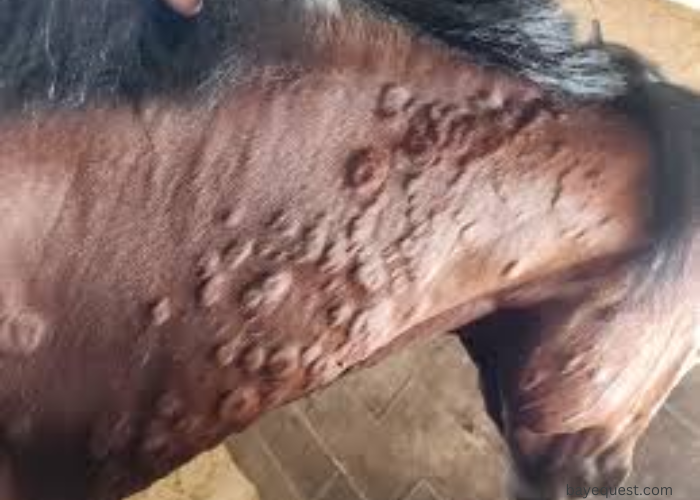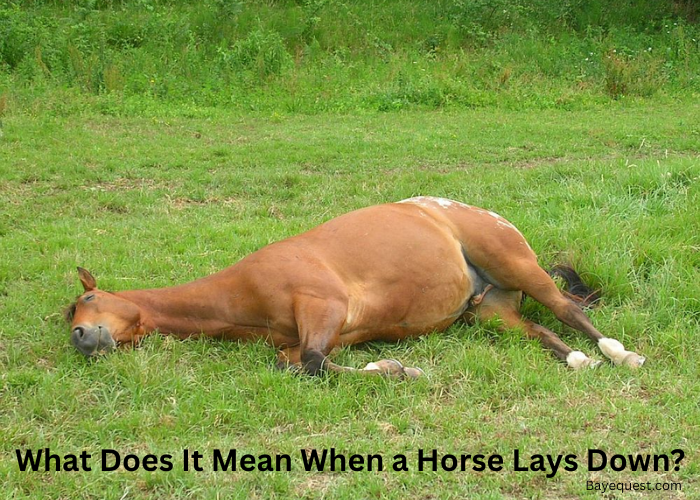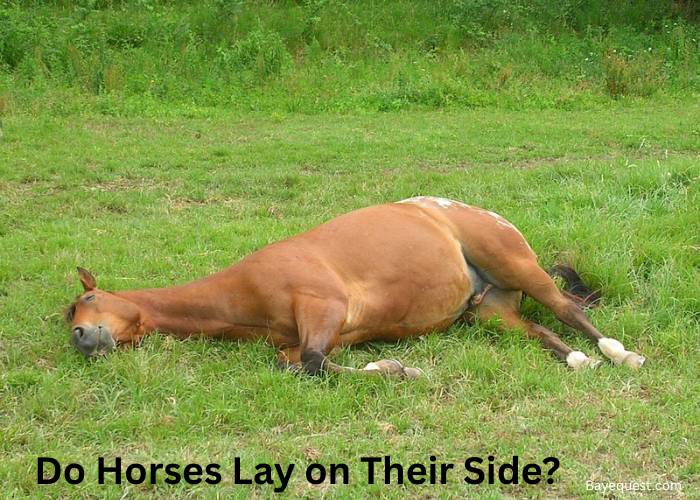Hives are a common skin issue that many horse owners face.
These raised, itchy bumps can appear suddenly and cause discomfort for your horse.
While hives often look alarming, they usually aren’t serious.
Understanding what causes hives, how to treat them, and ways to prevent them can make a big difference.
Whether it’s an allergic reaction or something in the environment, hives can pop up for several reasons.
In this blog, we’ll explore the main causes of hives in horses and offer practical advice on how to handle this problem.
What are Hives?
Hives, also known as urticaria, are raised, swollen patches on the skin that can appear suddenly.
They often look like small bumps or welts and can vary in size, from tiny spots to large, interconnected patches.
Hives can be itchy and cause discomfort, though they are usually not painful.
In horses, hives can appear anywhere on the body and may develop as a result of an allergic reaction, environmental irritants, stress, or even physical contact with certain substances.
While hives often resolve on their own, you need to understand the cause to prevent future outbreaks.
Types of Hives (Urticaria)
There are several types of hives that can affect horses, each with different causes and characteristics.
Here are the most common types:
Idiopathic Urticaria
Idiopathic urticaria refers to hives that appear with no identifiable cause.
In horses, this type of hives can be particularly frustrating because it occurs without a clear trigger.
The term “idiopathic” means the cause is unknown, and despite extensive testing, the exact reason for the reaction remains unclear.
Idiopathic hives can be either acute or chronic, and while they often resolve on their own, they may require management with antihistamines.
Physical Urticaria
Physical urticaria occurs in response to physical stimuli, such as pressure, cold, heat, sunlight, or friction.
This type of hives in horses can be triggered by specific physical factors, including:
Pressure-induced urticaria
Hives that develop where pressure is applied, such as from saddles, harnesses, or tight-fitting tack.
Cold-induced urticaria
Hives that appear after exposure to cold weather or cold water, usually in sensitive horses.
Heat-induced urticaria
Hives that develop in response to high temperatures or overheating, especially during strenuous exercise.
Solar urticaria
Rare, but some horses may develop hives due to exposure to direct sunlight.
Causes of Hives in Horses
Hives in horses can be caused by a variety of factors, ranging from allergies to environmental triggers. Here are the most common causes:
1. Allergic reactions
Food allergies. Horses may develop hives after eating certain feeds, supplements, or treats that trigger an allergic response.
Insect bites or stings. Bites from flies, mosquitoes, or other insects can cause localized hives, especially in horses that are sensitive to insect saliva.
Medications. Some horses may react to medications, including antibiotics or vaccines, resulting in hives.
2. Environmental allergens
Pollen, dust, and mold. Horses can develop hives due to inhaling or coming into contact with airborne allergens like pollen, dust mites, or mold spores.
Plants. Contact with certain plants or weeds in pastures or stalls can irritate the skin and cause hives.
3. Physical irritants
Tack or equipment. Pressure from poorly fitting saddles, harnesses, or blankets can cause pressure-induced hives.
Chemicals. Shampoos, grooming products, or cleaning agents that irritate the horse’s skin can lead to hives.
4. Stress
Horses, like humans, can experience hives due to stress. Emotional or physical stress from travel, changes in routine, or competition may trigger hives in some horses.
5. Weather conditions
Cold weather. Exposure to cold or sudden temperature changes can cause cold-induced hives in sensitive horses.
Heat or humidity. Excessive heat or sweating may irritate the skin and cause hives, especially in horses prone to skin reactions.
6. Idiopathic causes
Sometimes, the cause of hives cannot be identified. These are referred to as idiopathic hives and can occur without any obvious external or internal triggers.
Signs and Symptoms of Hives
The signs and symptoms of hives in horses are usually easy to spot due to the noticeable changes in the skin.
Here’s what to look out for:
1. Raised, swollen bumps (Welts)
The most common sign of hives is raised, round or irregular-shaped welts on the horse’s skin.
These welts can range in size and may cover small or large areas of the body.
2. Itchiness
Horses with hives may experience itching or discomfort, leading them to scratch, rub, or bite at the affected areas.
3. Swelling
Swelling may occur around the hives, and in more severe cases, it can extend to areas like the face, eyelids, or legs.
4. Heat
The affected areas can feel warm to the touch due to inflammation and swelling associated with the hives.
5. Hair standing up
In some cases, the hair over the hives may stand up, giving the horse’s coat a rough or uneven appearance.
6. Sudden onset
Hives often appear suddenly, usually within a few hours of exposure to the allergen or irritant.
7. Spreading
While some hives remain localized, others can spread across larger areas of the horse’s body, including the neck, back, and sides.
8. Behavioral changes
Horses with severe itching or discomfort may exhibit restless behavior, such as constant shifting, rolling, or acting agitated.
How to Diagnose Hives
Diagnosing hives in horses involves a thorough evaluation to determine the underlying cause.
Since hives can result from a wide range of factors, identifying the trigger is key to proper treatment and prevention.
Below is a step-by-step guide on how to diagnose hives.
1. Visual examination
The first step in diagnosing hives is a thorough visual examination by the owner or a veterinarian.
Hives usually appear as raised, swollen welts that can vary in size and may be localized or spread across the horse’s body.
The vet will note the size, shape, and distribution of the hives to begin narrowing down potential causes.
2. Review of recent history
The vet will ask about the horse’s recent history to identify any possible triggers. Important questions include:
Has the horse been exposed to new food, supplements, or medications?
Has the horse recently been vaccinated or treated with topical products?
Has there been contact with new plants, chemicals, or grooming products?
Have there been changes in weather, environment, or exposure to insects? This helps the vet identify potential allergens or irritants that may have triggered the hives.
3. Serology (Blood Tests)
Serology is a blood test that looks for IgE antibodies, which are produced in response to allergens. Here’s how it works:
A blood sample is taken and sent to a laboratory for testing against various allergens (e.g., pollen, mold, dust mites).
The lab checks for elevated IgE levels, indicating an allergic reaction to specific substances.
These tests help identify potential triggers of hives, particularly when environmental or food allergies are suspected.
While useful, serology can sometimes produce false positives, so the results are often combined with other diagnostic methods for confirmation.
4. Intradermal skin testing
Intradermal skin testing is considered more accurate for diagnosing environmental allergies.
Here’s how the test is conducted:
The horse is sedated, and a small area of the skin is shaved. Small amounts of allergens are injected under the skin in a grid pattern.
The vet monitors the injection sites for any swelling, redness, or raised bumps, indicating a positive reaction.
This test helps in pinpointing allergens in the horse’s environment, and the results guide treatment and prevention strategies.
5. Elimination trials
If food allergies are suspected, an elimination trial may be recommended.
This involves removing certain feeds or supplements from the horse’s diet to see if the hives resolve.
Once the horse is hive-free, items are gradually reintroduced to identify the specific allergen.
6. Biopsy (In rare cases)
In cases where the hives are persistent, unusual, or do not respond to treatment, a skin biopsy may be performed.
A small sample of skin is taken and examined under a microscope to rule out other skin conditions, infections, or autoimmune disorders.
7. Observation and monitoring
For hives with no obvious cause (idiopathic urticaria), observation is crucial.
Keeping track of when the hives occur, along with any recent changes in the horse’s environment, diet, or routine, can help in identifying patterns.
Sometimes, it takes careful monitoring over time to uncover the trigger.
8. Testing for underlying health issues
If the hives are chronic or severe, the vet may explore other health conditions that could be contributing factors.
Treatment of Urticaria
Treatment of Urticaria (Hives) in Horses
Treating urticaria in horses focuses on relieving symptoms, reducing discomfort, and preventing future outbreaks.
The approach to treatment may vary depending on the severity of the hives and the identified trigger.
Here are the steps for treating urticaria in horses:
1. Remove the trigger
If the cause of the hives is known, remove the trigger as quickly as possible.
This often results in the hives resolving on their own within a few hours or days.
In cases of environmental triggers, relocate the horse to a cleaner, allergen-free area.
2. Cold water baths
Bathing the horse with cool or cold water can help reduce inflammation and soothe irritated skin.
Use gentle, hypoallergenic shampoos to avoid further irritation.
Avoid using hot water, as it may exacerbate itching or discomfort.
3. Topical treatments
Over-the-counter topical creams designed for itchy or irritated skin can provide relief.
Products that contain ingredients like aloe vera or calamine are commonly used to reduce inflammation and itching.
In some cases, a vet may recommend a corticosteroid cream for more severe outbreaks.
4. Antihistamines
Oral antihistamines are commonly prescribed to reduce itching and swelling in horses with urticaria.
These medications block the effects of histamines, which are released during allergic reactions.
Antihistamines, such as Benadryl or hydroxyzine, can be used in mild to moderate cases.
5. Corticosteroids
Corticosteroid injections or oral medications may be used in more severe cases to reduce inflammation and immune responses.
Common corticosteroids include dexamethasone and prednisolone.
These drugs are powerful anti-inflammatories that should only be used under veterinary supervision.
Related read: What is the Right Dosage for Dexamethasone?
6. Epinephrine (for severe allergic reactions)
In rare, life-threatening cases where hives are accompanied by severe swelling, angioedema or respiratory distress, a vet may administer epinephrine (adrenaline).
What is the Prognosis of Urticaria in Horses?
The prognosis for urticaria in horses is usually good. Most cases are mild and clear up on their own or with basic treatment.
When hives are triggered by things like insect bites, medication, or allergens, they often disappear within a few hours to a few days.
Around 75% of acute cases resolve quickly, either naturally or with the help of antihistamines or topical treatments.
Chronic urticaria, where hives last for weeks or months, affects about 10-20% of horses.
These cases can be harder to manage since finding the exact cause is challenging.
Chronic cases often require long-term management, such as avoiding triggers or using immunotherapy.
With the right care, horses with chronic hives can still lead healthy lives.
In rare cases, horses may develop severe reactions, like angioedema, where swelling affects the throat or eyes.
This can cause breathing difficulties, but it’s uncommon, happening in less than 1-5% of cases.
Immediate treatment with corticosteroids or epinephrine is necessary in these situations, and most horses recover well with quick intervention.
Overall, the outlook for horses with hives is excellent.
With proper treatment and by avoiding known triggers, most horses recover fully and remain healthy.
How to Prevent Hives in Horses
Preventing hives in horses involves managing their environment, diet, and exposure to potential allergens.
Here are some effective ways to reduce the risk of hives:
1. Identify and avoid known triggers
If your horse has a history of hives, try to identify the cause, such as specific foods, medications, or environmental factors like pollen or dust.
Avoiding these triggers is the best way to prevent future outbreaks.
2. Use hypoallergenic products
Choose mild, hypoallergenic grooming products and shampoos to reduce skin irritation.
Be cautious when introducing new products and always test a small area first.
3. Keep the environment clean
Ensure that stalls and barns are free from dust, mold, and other airborne allergens.
Regular cleaning of bedding, equipment, and feeding areas helps reduce the chance of your horse coming into contact with irritants.
4. Manage insect exposure
Use insect repellents and protective fly sheets to minimize insect bites, which can trigger hives.
Keep horses in during peak insect activity, such as dawn and dusk.
5. Monitor feed and supplements
Be cautious when changing your horse’s feed or supplements. Introduce new foods slowly and monitor for any allergic reactions.
If food allergies are suspected, consider using a hypoallergenic feed.
6. Minimize stress
Stress can trigger hives in some horses.
Keeping your horse’s routine consistent and reducing stress from travel, competition, or changes in the environment can help prevent outbreaks.
Heat Bumps on Horses: Conclusion
Hives in horses may seem alarming, but they’re often easy to manage with the right care.
Identifying triggers and taking quick action can help prevent future outbreaks.
Whether caused by allergens, stress, or irritants, most cases resolve quickly with simple treatments.
By keeping your horse’s environment clean, using hypoallergenic products, and minimizing exposure to potential triggers, you can help keep hives at bay.
If hives persist or worsen, always consult a vet.
With proper management, your horse can stay comfortable and healthy, free from the irritation of hives.








